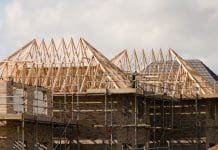The latest housing pipeline report from HBF and Glenigan has revealed that planning permissions were granted for over 350,000 new homes in 2017, offering a clear demonstration of the commitment of housebuilders to deliver even more new homes in the years to come
Housing supply is up 74% in the past four years, with over 217,000 new homes completed last year, meaning the industry is well on track to deliver the Government’s previous housing target of a million homes over the period 2015-2020. However, further improvements to the planning system and the business environment for small house builders will be needed to get closer to the Prime Minister’s 300,000 a year target set for the mid-2020s.
The 351,169 permissions granted in England last year is the highest since HBF and Glenigan began the Housing Pipeline series in 2006. These will be permissions that are built over the next several years, a positive indicator of future supply levels.
Despite this, not all of the permissions will yet be at the stage where builders can actually start work on site and one of the challenges for Government as it revises the National Planning Policy Framework will be to speed up the time it takes to get from an outline permission, when it is agreed to build on a plot of land, to an implementable one, whereby construction work can actually start.
Revisions to the NPPF also need to focus on why permissions are increasingly on larger sites as local authorities, faced with financial pressures, seek to minimise the number of areas on which development will take place. Whilst the number of plots approved in 2017 was 35% higher than in 2006, there were 3.5% fewer sites permitted last year. With larger sites typically requiring greater upfront capital and more extensive infrastructure, it can take longer for sites to reach peak build out rates, and SME builders are unable to compete for sites.
Stewart Baseley, Executive Chairman of the Home Builders Federation said:
“The record number of applications being submitted and approved is a clear demonstration of the industry’s commitment to ramping up housing supply even further than the unprecedented increases of the last four years. To build more home needs more land to come through the planning system more quickly, and to encompass a broader range of sites. SME builder numbers are down by more than 80% in recent decades as layer upon layer of legislation has worked against small firms and start-ups as well as those delivering specialist housing such as retirement homes.
“Government should ensure councils are not just taking the easy option and encourage them to grant permissions on a range of sites by type and size rather than merely relying on a few larger sites to meet local housing need.”
Glenigan’s Economics Director, Allan Wilen, added: “The residential development pipeline remains strong, with a rise in approvals during the fourth quarter taking the total for 2017 to 351,169 units, a 21% increase on the previous year. The increase in approvals bodes well for potential new housing activity over the coming year as housebuilders are able to bring forward development on these new sites in response to demand.”










![[VIDEO]Government launches new online appeal service for local planning authorities Group of young coworkers using computers in their group office, representing the new online appeals service](https://www.pbctoday.co.uk/news/wp-content/uploads/2025/12/iStock-2191280160-218x150.jpg)


